What is a Fat transfer?
The terms Fat transfer, Fat injections, and Fat grafting all refer to the process of taking fat from an unwanted area of your body and re-injecting purified adipose fat tissues into another area of your body. The goal of Facial fat transfer procedure is to add fullness to the area of the face that needs more volume. As we age, the epidermis and dermis thins and the face loses volume. With the face, adipose fat can be transferred to the cheeks, nasolabial folds, jawline, and the lower eye area. This injected fat restores volume, as well as replenishing nutrients and blood supply to the the skin. This results in a more youthful appearance, and is the most natural way to rejuvenate your face.
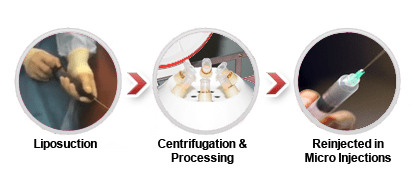
The procedure can be performed under local anesthesia or under monitored IV sedation. Fat transfer to the face is increasingly used instead of doing more invasive procedures like the Facelift. Most patients plan to go back to work at 10 days.
Fat grafting has been performed for over 100 years by plastic surgeons. Read more about the history of fat grafting here. During the past two decades, the Fat transfer procedure has evolved greatly. More recently, plastic surgeons have refined the processing component of the procedure to yield a quantity of fat that has highly viable cells. When cells have high viability, this means the fat graft is more likely to ‘take.’ This technique is sometimes referred to as ‘High Density Fat Grafting.’
What areas of the face benefit from fat injections?
Fat injections are commonly used to rejuvenate nearly all areas of the face. Fat injections are best used to fill in bags under the eyes, fill out the cheeks and chin areas to lift facial structure, or as an all purpose filler.
As we continue to understand the aging process better, we have come to appreciate that in some patients, rather than dissecting tissues and surgically lifting, adding soft tissue volume such as fat will make the face look younger. We find ourselves using fat injections as an integral part of Facelift surgery. In my own practice, I am increasingly doing less surgical dissection and more fat grafting in the facial areas.
The 3 components of Fat transfer are:
- extraction of fat with Liposuction
- processing and centrifugation of fat
- re-injection of fat
What problems does a Facial fat transfer address?
My face looks thin and sags - how do I get a youthful, glowing look? a Maryland patientFat transferred from other areas of your body to your face will not only give some lifting to the general facial structure, but can also improve the look of your skin. Patients seeking a fat transfer for facial rejuvenation often present these symptoms:
- fine lines and wrinkles
- crows feet
- under eye bags or dark circles
- worry and/or frown lines
- 'sunken' cheeks
- tired look
- fat loss from laser damage
- fat loss from disease
How are fat injections different from injectable fillers like Juvederm?
Compared to injectable facial fillers such as Juvederm, the fat transfer procedure is more involved because the fat has to first be harvested from another part of the body with Liposuction. However, unlike injectable fillers, fat transfers can be used in larger volumes to fill larger defects. And above all, fat injections are a natural type of surgical enhancement, and they contain a small population of regenerating adipose stem cells.Do fat injections last?
When a Fat transfer is performed properly, a large percentage of the injected fat cells do indeed survive and are permanent. - Dr. RodriguezSome patients think that fat injections "do not last." However, this is not the case. When a fat transfer is performed properly, a large percentage of the injected fat cells do indeed survive and are permanent. However, since some fat cells are lost in the immediate post op period, we tend to 'over-correct,' or inject more than we need to. After the majority of the swelling is gone, approximately two weeks later, you will have a very good idea of what the final result will be.
How are Fat transfers performed?
Type of Anesthesia
Fat injections can be done under local or monitored IV sedation anesthesia. If only one area of fat is being injected, such as under the eyes, this can easily be accomplished using local anesthesia. This is comparable to going to the dentist office, in that the area is numbed with a local anesthetic.Surgical Technique
The technique most commonly used in Facial fat grafting is the Coleman technique, pioneered by Dr. Sydney Coleman in the 1980's. There are basically 3 steps involved in this technique.1) Extraction of fat from unwanted areas with liposuction
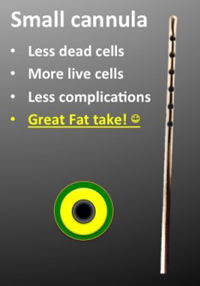 Using thin cannulas, fat is harvested from the hip, inner or outer thigh, lower back, or lower abdomen. These areas are called the 'donor sites.' The fat is collected into sterile canisters.
In order to get the best fat graft, I believe that slender cannulas with small holes should be used for the fat extraction. This is further discussed in my blog post here.
Using thin cannulas, fat is harvested from the hip, inner or outer thigh, lower back, or lower abdomen. These areas are called the 'donor sites.' The fat is collected into sterile canisters.
In order to get the best fat graft, I believe that slender cannulas with small holes should be used for the fat extraction. This is further discussed in my blog post here.
2) Decanting and centrifugation of adipose lipoaspirate
The extracted lipoaspirate fat is then decanted and processed in a special centrifuge. The purpose of this step is to separate the viable fat cells from the poor quality fat cells. After centrifugation, the poor fat cells will float to the top. What remains in the sterile tube is a highly viable pellet of adipose tissue.3) Fat injection into recipient area
Using only the most viable fat cells that survive the centrifugation, this adipose fat is then injected into the desired facial area(s). The common areas include the the area under the eyes, cheeks, nasolabial folds, chin, lips, and jawline. The area where the fat is re-injected is called the 'recipient site.' When performed properly, a large percentage of the fat transfer will 'take' and the face will fill out to look more youthful.High density Fat grafting vs. Cell enhanced Fat grafting
High density fat grafting is not the same as Cell enhanced Fat grafting, where collagenase is used with centrifugation to increase the population of adipose stem cells. Cell Enhanced Fat grafting goes a step beyond typical high density fat transfer techniques, and requires IRB (Institutional Review Board) or FDA (Food and Drug Administration) oversight. Nevertheless, there *are* small ASC populations in high density fat grafts and they can have a positive effect on the skin. Adipose Stem Cells are truly the new fountain of youth, and this is an exciting new field of Plastic Surgery!What are the preoperative requirements?
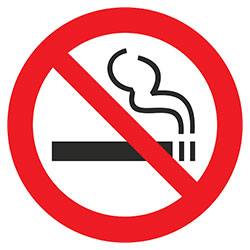 During your consultation, we'll discuss the liposuction areas as well as fat injection areas to determine the best surgical plan to achieve your goals. Be sure to listen to all of the pre-op instructions and get answers to any concerns you may have. Pre-op instructions will depend heavily on whether you elect to have the procedure under local or IV anesthesia.
During your consultation, we'll discuss the liposuction areas as well as fat injection areas to determine the best surgical plan to achieve your goals. Be sure to listen to all of the pre-op instructions and get answers to any concerns you may have. Pre-op instructions will depend heavily on whether you elect to have the procedure under local or IV anesthesia.
Fat transfer under local anesthesia
If you are doing Fat transfer to one area, such as under your eyes or your cheeks, this procedure can be performed under local anesthesia. This is comparable to going to the dentist, but you will feel some temporary discomfort during the liposuction part. The attraction to have the procedure done under local is that the total cost is less compared to monitored IV sedation. In addition, with local procedures preoperative testing is not required. Patients are eligible to have local anesthesia if they are having one area of fat grafting. Fat transfer to multiple areas of the face are better tolerated with IV sedation. We do not perform multiple area fat transfer under local anesthesia.Fat transfer under monitored IV sedation
For those patients having the procedure performed under IV anesthesia, you will need a pre-operative clearance from your physician within 30 days of your surgery date. If you are healthy, this includes an H&P (physical) and a CBC blood test. Prior to your surgery, you should meet with your surgeon to discuss the Informed Consent for the procedure. This is the opportunity to ask questions and review post op instructions. Lastly, you should stop smoking 3-4 weeks prior to the surgery for the best results. Smoking does adversely affect the way you heal!What is Fat transfer Post-Op recovery like?
You will likely have some discomfort as well as some swelling during the immediate post op period. For a Fat graft to be as successful as possible you'll need to avoid stressing the fat injection area(s) for three weeks. It takes up to 4 days for the blood vessels to grow into the fat grafts and another 2 or 3 days for the blood vessels to strengthen. It takes 2 to 3 weeks for the extracellular matrix surrounding the fat graft to reach enough strength to withstand minor stresses. Post op instructions for facial fat grafting include the following:- wear surgical tape or compression garment on facial areas for 5 days
- sleep on back with head elevated for the first week
- no rubbing of the face or putting pressure on face for 2 weeks (only soft washing)
- post op office visit at day 5-6
- return to work after 1 - 2 weeks
- exercise as tolerated after 2 weeks
- follow up office visits at month 1, month 4
What are the risks and possible complications?
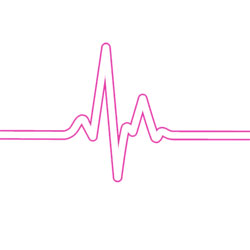 As with any cosmetic surgery procedure there are risks and complications associated with fat transfers. Possible concerns include:
As with any cosmetic surgery procedure there are risks and complications associated with fat transfers. Possible concerns include:
- swelling
- irregular contours or uneven results from liposuction
- hematoma
- seroma
- skin necrosis
- fat necrosis
- touch up or secondary procedure to achieve desired results
- asymmetry
How much does Facial fat transfer cost?
Cost for a Facial fat transfer in 2024 varies depending on the area(s) to be injected, and the type of anesthesia used. In most cases, the procedure can be performed under local anesthesia. More than one area of Fat transfer must be performed under IV sedation. For sedation cases, we use only Board Certified Anesthesiologists. Total cost estimates for surgeries performed in 2024 are as follows (exp 5/1/24):| Facial fat grafting | Local anesthesia | IV anesthesia |
|---|---|---|
| One area (ex: cheeks, under eyes) | $3,200 - $4,500 | $4,500 - $6,400 |
| Full face (ex: cheeks, under eyes, nasolabial folds) | not applicable | $7,200 - $8,200 |
 Can I finance my Facial fat transfer?
Can I finance my Facial fat transfer?
Yes, we work with a number of finance companies so that you can have a low, affordable, monthly payment. Please call the office at 410-494-8100 or see our financing section for more information.

Board Certified Plastic Surgery, ASPS Member
NOTICE
Patients depicted in our before and after galleries have provided their written consent to display their photos online. Every patient is unique, and surgical results may vary. Please contact us if you have any questions.

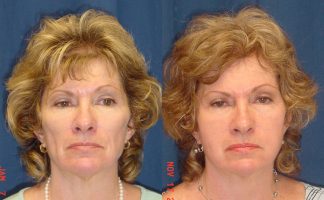
 Can I finance my Facial fat transfer?
Can I finance my Facial fat transfer?